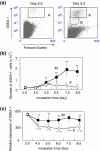Analysis of chicken primordial germ cells
- PMID: 19003166
- PMCID: PMC2553664
- DOI: 10.1007/s10616-008-9156-x
Analysis of chicken primordial germ cells
Abstract
Primordial germ cells (PGCs) are precursors of germline cells. Although avian PGCs have been used to produce transgenic birds, their characteristics largely remain unknown. In this study, we isolated PGCs from chicken embryos at various developmental stages and analyzed the gene expression. Using the expression of stage-specific embryonic antigen-1 (SSEA-1) as a marker of chicken PGCs, we purified PGCs from embryos by fluorescence-activated cell sorting after incubation for 2.5-8.5 days. The number of SSEA-1(+) cells was almost unchanged during days 2.5-8.5 of incubation in females but continuously increased in male. Expression of several genes, including Blimp1, SOX2, and CXCR4, was observed in SSEA-1(+) cells but not in SSEA-1(-) cells in both female and male embryos. Quantitative reverse-transcription PCR analysis revealed that the expression of CXCR4, a chemokine receptor essential for migration of PGCs from the bloodstream to the gonads, was reduced after the circulating PGC stage (day 2.5).
Figures



Similar articles
-
Development of novel markers for the characterization of chicken primordial germ cells.Stem Cells. 2005 May;23(5):689-98. doi: 10.1634/stemcells.2004-0208. Stem Cells. 2005. PMID: 15849176
-
PRDM14 and BLIMP1 control the development of chicken primordial germ cells.Dev Biol. 2019 Nov 1;455(1):32-41. doi: 10.1016/j.ydbio.2019.06.018. Epub 2019 Jul 2. Dev Biol. 2019. PMID: 31271752
-
Expression dynamics of pluripotency genes in chicken primordial germ cells before and after colonization of the genital ridges.Mol Reprod Dev. 2013 Oct;80(10):849-61. doi: 10.1002/mrd.22216. Epub 2013 Aug 2. Mol Reprod Dev. 2013. PMID: 23877993
-
The early development of germ cells in chicken.Int J Dev Biol. 2018;62(1-2-3):145-152. doi: 10.1387/ijdb.170283jh. Int J Dev Biol. 2018. PMID: 29616722 Review.
-
Formation, Application, and Significance of Chicken Primordial Germ Cells: A Review.Animals (Basel). 2023 Mar 20;13(6):1096. doi: 10.3390/ani13061096. Animals (Basel). 2023. PMID: 36978637 Free PMC article. Review.
Cited by
-
Expression patterns of prdm1 during chicken embryonic and germline development.Cell Tissue Res. 2014 May;356(2):341-56. doi: 10.1007/s00441-014-1804-1. Epub 2014 Apr 2. Cell Tissue Res. 2014. PMID: 24691770 Free PMC article.
-
In Vitro Culture of Chicken Circulating and Gonadal Primordial Germ Cells on a Somatic Feeder Layer of Avian Origin.Animals (Basel). 2020 Sep 30;10(10):1769. doi: 10.3390/ani10101769. Animals (Basel). 2020. PMID: 33007811 Free PMC article.
-
Comparative analysis of temporal gene expression patterns in the developing ovary of the embryonic chicken.J Reprod Dev. 2015;61(2):123-33. doi: 10.1262/jrd.2014-084. Epub 2015 Jan 2. J Reprod Dev. 2015. PMID: 25736178 Free PMC article.
-
Ascorbic acid and all-trans retinoic acid promote proliferation of chicken blastoderm cells (cBCs) by mediating DNA demethylation.In Vitro Cell Dev Biol Anim. 2022 Mar;58(3):199-209. doi: 10.1007/s11626-022-00659-w. Epub 2022 Mar 14. In Vitro Cell Dev Biol Anim. 2022. PMID: 35288810
-
Vertebrate Lineages Exhibit Diverse Patterns of Transposable Element Regulation and Expression across Tissues.Genome Biol Evol. 2020 May 1;12(5):506-521. doi: 10.1093/gbe/evaa068. Genome Biol Evol. 2020. PMID: 32271917 Free PMC article.
References
-
- {'text': '', 'ref_index': 1, 'ids': [{'type': 'DOI', 'value': '10.1038/ncb1413', 'is_inner': False, 'url': 'https://doi.org/10.1038/ncb1413'}, {'type': 'PubMed', 'value': '16699504', 'is_inner': True, 'url': 'https://pubmed.ncbi.nlm.nih.gov/16699504/'}]}
- Ancelin K, Lange UC, Hajkova P et al (2006) Blimp1 associates with Prmt5 and directs histone arginine methylation in mouse germ cells. Nat Cell Biol 8:623–630. doi:10.1038/ncb1413 - PubMed
-
- {'text': '', 'ref_index': 1, 'ids': [{'type': 'DOI', 'value': '10.1016/j.cell.2005.08.020', 'is_inner': False, 'url': 'https://doi.org/10.1016/j.cell.2005.08.020'}, {'type': 'PMC', 'value': 'PMC3006442', 'is_inner': False, 'url': 'https://pmc.ncbi.nlm.nih.gov/articles/PMC3006442/'}, {'type': 'PubMed', 'value': '16153702', 'is_inner': True, 'url': 'https://pubmed.ncbi.nlm.nih.gov/16153702/'}]}
- Boyer LA, Lee TI, Cole MF et al (2005) Core transcriptional regulatory circuitry in human embryonic stem cells. Cell 122:947–956. doi:10.1016/j.cell.2005.08.020 - PMC - PubMed
-
- {'text': '', 'ref_index': 1, 'ids': [{'type': 'PubMed', 'value': '7818175', 'is_inner': True, 'url': 'https://pubmed.ncbi.nlm.nih.gov/7818175/'}]}
- Clinton M (1994) A rapid protocol for sexing chick embryos (Gallus g. domesticus). Anim Genet 25:361–362 - PubMed
-
- None
- Etches RJ (1995) Physiology of reproduction: the female. In: Hunton P (ed) Poultry production. Elsevier, Amsterdam, pp 221–241
-
- {'text': '', 'ref_index': 1, 'ids': [{'type': 'DOI', 'value': '10.1016/0012-1606(76)90178-0', 'is_inner': False, 'url': 'https://doi.org/10.1016/0012-1606(76)90178-0'}, {'type': 'PubMed', 'value': '944662', 'is_inner': True, 'url': 'https://pubmed.ncbi.nlm.nih.gov/944662/'}]}
- Eyal-Giladi H, Kochav S (1976) From cleavage to primitive streak formation: a complementary normal table and a new look at the first stages of the development of the chick. I. General morphology. Dev Biol 49:321–337. doi:10.1016/0012-1606(76)90178-0 - PubMed
LinkOut - more resources
Full Text Sources
Other Literature Sources

